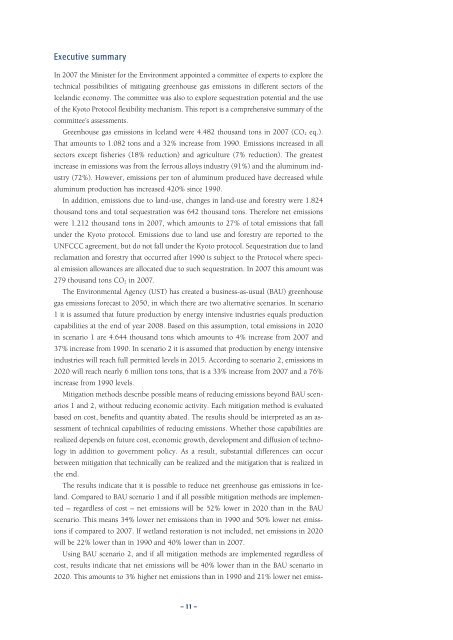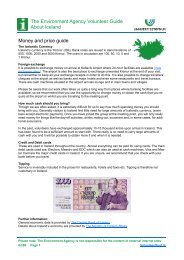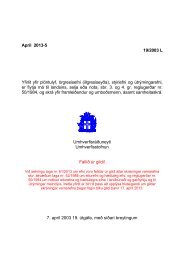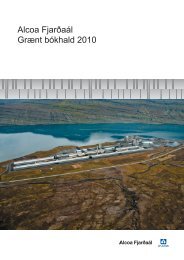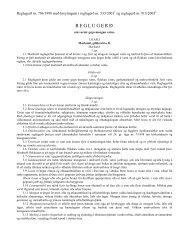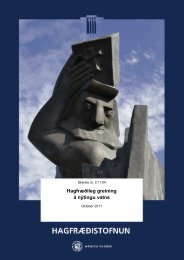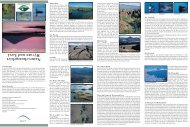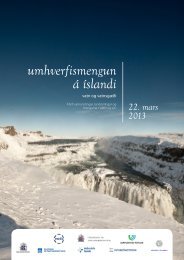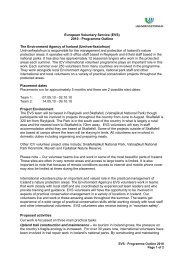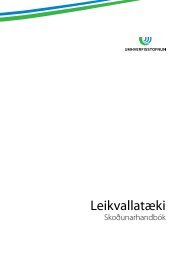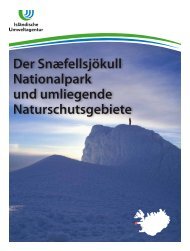Möguleikar til að draga úr nettóútstreymi gróðurhúsalofttegunda á ...
Möguleikar til að draga úr nettóútstreymi gróðurhúsalofttegunda á ...
Möguleikar til að draga úr nettóútstreymi gróðurhúsalofttegunda á ...
- No tags were found...
Create successful ePaper yourself
Turn your PDF publications into a flip-book with our unique Google optimized e-Paper software.
Executive summaryIn 2007 the Minister for the Environment appointed a committee of experts to explore thetechnical possibilities of mitigating greenhouse gas emissions in different sectors of theIcelandic economy. The committee was also to explore sequestration potential and the useof the Kyoto Protocol flexibility mechanism. This report is a comprehensive summary of thecommittee’s assessments.Greenhouse gas emissions in Iceland were 4.482 thousand tons in 2007 (CO 2 eq.).That amounts to 1.082 tons and a 32% increase from 1990. Emissions increased in allsectors except fisheries (18% reduction) and agriculture (7% reduction). The greatestincrease in emissions was from the ferrous alloys industry (91%) and the aluminum industry(72%). However, emissions per ton of aluminum produced have decreased whilealuminum production has increased 420% since 1990.In addition, emissions due to land-use, changes in land-use and forestry were 1.824thousand tons and total sequestration was 642 thousand tons. Therefore net emissionswere 1.212 thousand tons in 2007, which amounts to 27% of total emissions that fallunder the Kyoto protocol. Emissions due to land use and forestry are reported to theUNFCCC agreement, but do not fall under the Kyoto protocol. Sequestration due to landreclamation and forestry that occurred after 1990 is subject to the Protocol where specialemission allowances are allocated due to such sequestration. In 2007 this amount was279 thousand tons CO 2 in 2007.The Environmental Agency (UST) has created a business-as-usual (BAU) greenhousegas emissions forecast to 2050, in which there are two alternative scenarios. In scenario1 it is assumed that future production by energy intensive industries equals productioncapabilities at the end of year 2008. Based on this assumption, total emissions in 2020in scenario 1 are 4.644 thousand tons which amounts to 4% increase from 2007 and37% increase from 1990. In scenario 2 it is assumed that production by energy intensiveindustries will reach full permitted levels in 2015. According to scenario 2, emissions in2020 will reach nearly 6 million tons tons, that is a 33% increase from 2007 and a 76%increase from 1990 levels.Mitigation methods describe possible means of reducing emissions beyond BAU scenarios1 and 2, without reducing economic activity. Each mitigation method is evaluatedbased on cost, benefits and quantity abated. The results should be interpreted as an assessmentof technical capabilities of reducing emissions. Whether those capabilities arerealized depends on future cost, economic growth, development and diffusion of technologyin addition to government policy. As a result, substantial differences can occurbetween mitigation that technically can be realized and the mitigation that is realized inthe end.The results indicate that it is possible to reduce net greenhouse gas emissions in Iceland.Compared to BAU scenario 1 and if all possible mitigation methods are implemented– regardless of cost – net emissions will be 52% lower in 2020 than in the BAUscenario. This means 34% lower net emissions than in 1990 and 50% lower net emissionsif compared to 2007. If wetland restoration is not included, net emissions in 2020will be 22% lower than in 1990 and 40% lower than in 2007.Using BAU scenario 2, and if all mitigation methods are implemented regardless ofcost, results indicate that net emissions will be 40% lower than in the BAU scenario in2020. This amounts to 3% higher net emissions than in 1990 and 21% lower net emiss-– 11 –


